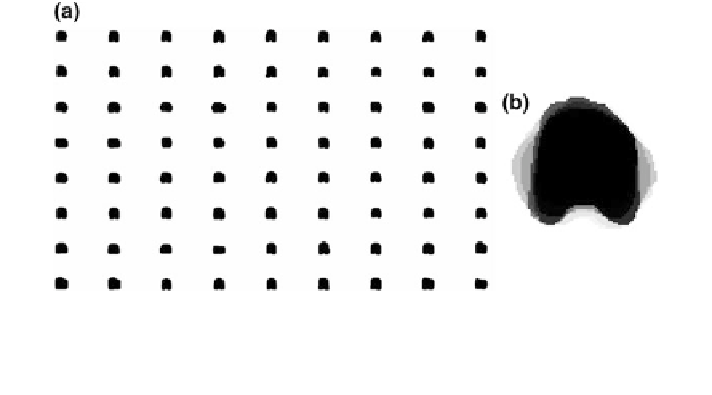Information Technology Reference
In-Depth Information
2.4.2 The Registration of Training Shapes
For the training stage, 80 VB cross-sections (34 thoracic, 34 lumbar, 12 cervical)
are used. These VBs are selected form 10 healthy and 10 with low bone mass
patients. The more information about the testing CT data sets will be given in the
experimental section.
In this subsection, we overview the shape representation approach used in this
work. The training set consists of VB shapes, {C
1
; ...;
C
N
}, as shown in Fig.
11
;
with the signed distance functions {
/
1
; ...; /
N
}. Any pixel in this shape repre-
sentation is shown as x. The registration of all training shapes is done using the
similar approach described in [
28
] and used in [
29
,
30
] as follows:
1. First, the average of the position factor (
l
) and scale factor (
r
) are obtained
using the following equations
T
P
N
i¼1
P
X
xH
ð/
i
ð
x
ÞÞ
P
N
i¼1
P
X
yH
ð/
i
ð
x
ÞÞ
T
l
x
l
y
P
i¼1
P
X
H
ð/
i
ð
x
ÞÞ
P
i¼1
P
X
H
ð/
i
ð
x
ÞÞ
l
¼
¼
;
ð
12
Þ
T
P
N
i¼1
P
X
ð
x
l
x
Þ
P
N
i¼1
P
X
ð
y
l
y
Þ
T
2
H
2
H
ð/
i
ð
x
ÞÞ
ð/
i
ð
x
ÞÞ
r
x
r
y
P
i¼1
P
X
H
ð/
i
ð
x
ÞÞ
P
i¼1
P
X
H
ð/
i
ð
x
ÞÞ
r
¼
¼
; ð
13
Þ
ð:Þ is the Heaviside step function.
2. A global transformation is used to register training shapes with scale and
translation parameters. The transformation has scaling, S, and translation
where
H
Fig. 11 a The training VB images. In this experiment, 80 VB shapes which are obtained from 20
different patients and different regions (such as cervical, thoracic, and lumbar spine bone sections)
are proposed. b The average shape of all training VB images. The darker color represents the
higher object probability



